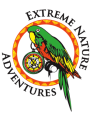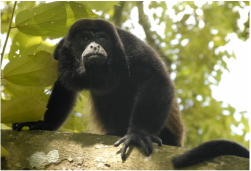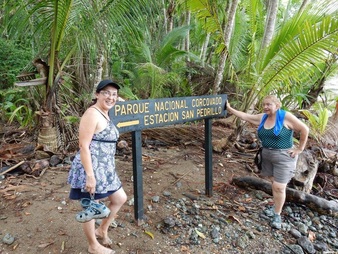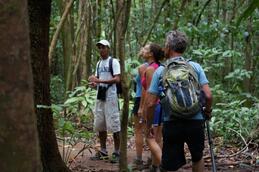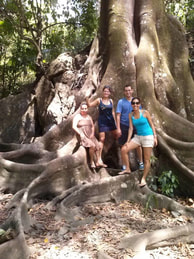Corcovado National Park Costa Rica
|
Those who prefer high outdoor adventure, sign up for a visit to "the most biologically intense place on the planet," (National Geographic, 2004) the Corcovado National Park; animal and bird watching and hiking. Corcovado Park tour is $130/person and includes Park Ticket, Guide, Lunch and Boat Transportation down the Rio Sierpe to Corcovado Park.
We leave Sierpe de Osa by boat down a scenic river called the rio sierpe where you can see amazing wildlife such as the two and three toed sloth, exotic birds, squirrel monkey and lots more! At the end of the river mouth we reach the Pacific Ocean and cross over to the Corcovado Park Ranger Stations to begin the hike. |
|
These ocean waters are close to the biological reserve, Cano Island, and are full of aquatic life such as whales, dolphins & sea turtles! Corcovado Park Tour Departs Sierpe at 8:30am and returns by 4pm.
Corcovado is one of Costa Rica's most remote parks. There is no road access to any portion of the park's perimeter. Boat access from Sierpe is supported at the San Pedrillo and Sirena ranger stations. Corcovado National Park is acquainted with a variety of descriptive sobriquets attesting to the splendor of its natural history and resident wildlife. |
|
The park contains the largest contiguous expanse of primary tropical rain forest north of the Amazon basin, it is frequently reported, and the park is widely known to contain within its boundaries 2.5% of the biodiversity of the entire planet. While this Biodiversity is partly explained by Corcovado's geographic location along the land bridge connecting the North and South American continents, the diversity of forest types within Corcovado itself is a strong predictor of zoologic diversity as well. At least thirteen distinct vegetation types identified within the park boundaries provide habitat for a mind-numbing list of animal species.
|
|
Corcovado National Park is remarkable for a reason completely different from its biodiversity and ecologic splendor as well, one likely to bear on environmental protections in other Latin American nations now and in the near future. Corcovado has been at the crossroads for the past forty years of environmental conservation and resource exploitation. With attractive gold and timber reserves in great abundance, the conservation advocates that succeeded in establishing the park have had to battle a the dramatic apparent economic favor of rapacity over conservation. But timber and gold are short-lived if dramatic economic windfalls, and the protection of Corcovado promises long-term and stable returns.
Sustainable development has enabled ecotourism to provide an alternative to subsistence farming, logging, and mining, and the testament to the success is in the evolving public pride in the environmental protection of public lands in this country. But the implications are planetary as most of the world's vital remaining unspoiled habitat is contained by societies struggling with economic issues not unlike those that Costa Rica has and continues to overcome through diligence and national discipline. |
